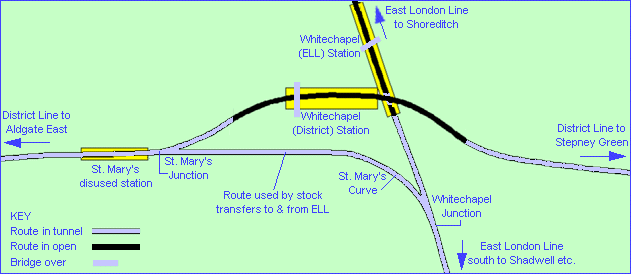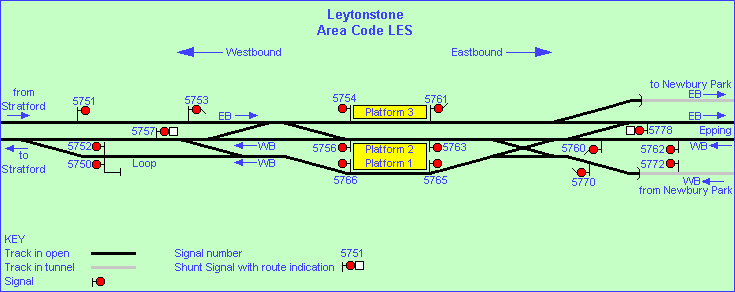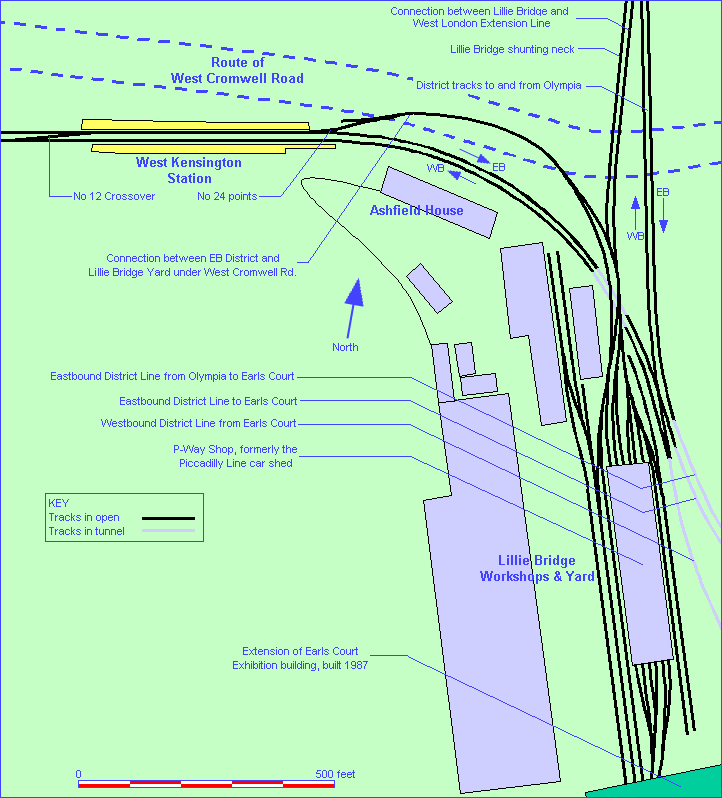Route and Track Diagrams
From time to time, questions are asked of Tubeprune or raised
in uk.transport.london about the route and track arrangements of certain areas of London
Underground. Below are links to diagrams and descriptions of some of the areas asked
about.
Contents
Whitechapel Area - Leytonstone Routes - Connections at Lillie Bridge
Links to:
Central Line at White City
- Victoria Line Signalling Diagrams (Complete)
- Northern Line Signalling Diagrams (Controlled
Areas) - Epping - Ongar
Branch

This is a diagram of the Underground routes,
approximately to scale, of the area around Whitechapel. The approach from Aldgate
East is under the alignment of the Whitechapel Road. District and Metropolitan
trains pass through the disused station of St Mary's (closed in 1938) and then diverge
from the straight route under the Whitechapel Road to the left and rise up into the open
area around Whitechapel (District) station. The diverging route means that drivers
see a green signal with a 45º left route indicator at the east end of St Mary's
station. This is the Whitechapel outer home signal. There is a steep climb up
into the open area here at 1 in 50.
The curves (both horizontal and vertical) are
quite severe at both ends of Whitechapel platforms and there are 10 mph speed limits
there.
At the east end of Whitechapel station the line
passes over the East London Line platforms and then drops sharply (about 1 in 40) into the
tunnel towards Stepney Green.
The East London Line (ELL) is connected to the
District by a simple two-track route with a junction at each end. The junction at
the District (west) end is St Mary's Junction, while the one at the ELL end is Whitechapel
Junction. Whitechapel Junction is controlled from the ELL control room at New Cross
while St Mary's is controlled by Whitechapel signal cabin (code EN).
Whitechapel signal box is one of the last of the
original manually operated cabins on the system. It dates from 1907 and the present
frame was installed in 1951. Tubeprune remembers sitting with his guard in the cabin
for over an hour one evening many years ago watching the District service rattle past
while the H & C was suspended for a points failure at Baker Street and he was awaiting
instructions from the controller as to when he could take his train away. I remember
we made tea and toast for the signalman, who was rather busy.
To the Top of this Page
Back to the Home Page

This is the track and signalling diagram for
Leytonstone (Central Line) prepared with information as presently available to Tubeprune.
From the enquiry by "Kat" in uk.transport.london on 22 August 2002
regarding the ability of eastbound rains to run directly into Platform 2, this diagram
shows that signal 5753 will give a right hand route into Platform 2. Trains can then
run on to the Epping road from Platform 2 but not onto the Hainault loop towards Newbury
Park.
To the Top of this Page
Back to the Home Page

This is a diagram of the area between West
Kensington (District) station and Lillie Bridge Depot, now the main civil engineering
workshop for the Underground. All the tracks are shown near to scale. The
diagram shows the connection between West Kensington EB track and the yard of Lillie
Bridge depot, referred to in a question in uk.transport.london about the District spur at
West Kensington by Paul Tweedy on 25 August 2002.
Background
This is an interesting site. The land in
the area was mostly market gardens and orchards when the District opened new lines from
Gloucester Road to West Brompton and Olympia (then called Addison Road) in 1869. The
West London Extension Railway already ran between the two stations. The District
routes from Earls Court to both stations were in shallow cuttings throughout. Of
course, much of it is now in tunnel, having been covered by the Earls Court exhibition
halls.
The District built a depot at Lillie Bridge in
1871 to house and maintain its rolling stock. It had to because it had been relying
on the Metropolitan Railway to operate its trains up to that time and decided in 1870 that
it didn't like the way they were doing it and that, from the following year, they would do
it themselves. The main shop at Lillie bridge was built of concrete, believed to be
the first use of the material for such a large building. The only way trains could
access the depot was via a junction on the Addison Road route. A train would leave
Earls Court and proceed round the northern curve (now the WB road from Earls Court to
Olympia) towards Addison Road. It would stop clear of the District junction leading
to Lillie Bridge, and then reverse up the slope into the yard.
David Hayward reminded Tubeprune that there was a
connection west of the Lillie Bridge/Olympia junction to the WLER lines. Kensington
South Main signal box had a connection into the District signalling (a slot) whereby
engineers' trains and deliveries of rails etc. could be made into Lillie Bridge. It was a
single facing crossover. There are photos of ex GWR Panniers shunting at Olympia,
and that is how they got from the Olympia branch onto the WLER. The connection was
taken out years ago when the Eurostar trains to North Pole were provided with new
electrified upgraded track.
The line to Hammersmith via West Kensington was
opened in 1874. Again the route was rural and in a shallow cutting. Tubeprune
has no information to confirm this but he suspects that the link from West Kensington to
Lillie Bridge would have gone in around this time. It is now so tight to the
platform at West Ken. that it seem unlikely it would have been done when long trains were
running.
The next major event for the area was the
electrification of the District in 1905, followed shortly by the opening of the Piccadilly
Line in 1906. The District's depot at Lillie Bridge was largely superseded by a new
electric train depot at Ealing Common so part of it was offered to the Piccadilly as a
site for its depot. The old concrete shop was demolished and replaced by a 6-road,
brick built shed, the northern part of which still stands today. Originally, the
shed was long enough to allow 3 x 6-car trains to stable on each road and there was a
lifting shop at the back. Only the front third of it remains today.
Access to the Piccadilly depot was via the West
Ken. link. All Piccadilly trains leaving the depot had to go through West Ken.
station to Hammersmith, where the original terminus for the Piccadilly Line was
located. This only changed in 1932 when the Piccadilly Line extensions to Hounslow
and Uxbridge were started and a new depot was built at Northfields. The whole of the
Lillie Bridge site was then handed over to the engineering departments. It has
remained in their hands to this day. It was redeveloped in 1987 to allow the
extension of the Earls Court Exhibition halls over the southern end of the site.
The access track to West Ken. was always in the
open until the West Cromwell Road extension (see dotted lines in the drawing above) was
built over it in the early 1960s. Before 1932 there was a shunting neck next to it,
which was removed when the Piccadilly depot was moved to Northfields.
Operations
The layout at West Ken. is a bit unusual. In order to
get an engineer's train into the yard from the east, you have to reverse beyond No 12
crossover on the WB District track, which is at the west end of West Ken. station.
Well, almost. The east end of the crossover is actually within the normal stopping
point of a passenger train in the eastbound platform. More on this later.
An engineer's train coming from the eastern end of the
Piccadilly Line can pass through Barons Court siding and then reverse in Platform 3 of
Hammersmith station. The train can then crossover to the EB District and reach West
Ken. that way. All trains leaving Lillie Bridge via West Ken. have to run into the
EB platform and either reverse or proceed westwards over No 12 crossover.
For many years, it was the practice to run early morning
Piccadilly Line staff trains (i.e. they ran before stations were open to the public in
order to get staff to work) used to run to West Ken. and reverse there. Because of
the awkward layout, there was not enough room between the Lillie Bridge connection at the
east end and No 12 crossover at the west end to allow a 7-car Piccadilly train to
fit. So, in order to reverse a train there, the EB starting signal had to be cleared
and the driver had to stop his train with the leading cab a few feet past the
signal. In order not to get trains tripped, the trainstop and block joint were
located some distance in advance of the signal.
OK, the Piccadilly driver has stopped his train and he now
changes ends. If he has stopped in the right place, once in the west end cab of his
train, he will see the signal on the track, tucked under the edge of the platform, which
will allow him to use No 12 crossover to get back to Barons Court. It used to be a
shunt signal but it is now a standard signal. The operation always had to be quick
because there was usually a ballast train lurking in the area waiting to get into the yard
and there was a District staff train to Aldgate East about that early (05:00) too.
So far, so good. For years, this procedure worked very
well. However, on one celebrated morning in the late 1960s, the driver of a
Piccadilly staff train, new to this manoeuvre, failed to pull ahead of the EB starter at
West Ken. and thus failed to clear the shunt signal (or No 12 crossover) in rear
either. When he changed ends, he (and his guard) failed to notice the absence of a
signal to allow them to proceed. But proceed they did, the driver taking his train westbound
along the eastbound District track towards Barons Court. The driver of the EB
District staff to Aldgate East was stopping in Barons Court EB Platform and was somewhat
surprised to see the starter change from green and yellow to red as the Piccadilly train
approached him. Fortunately, the Piccadilly driver realised something was wrong when
he saw the Piccadilly Line tunnel mouth appear on his left instead of on his right and he
stopped before he hit the District train.
|